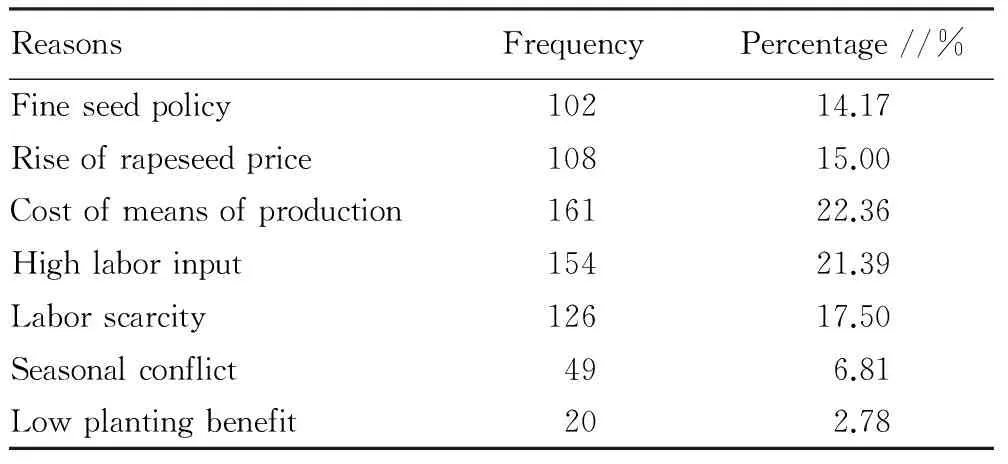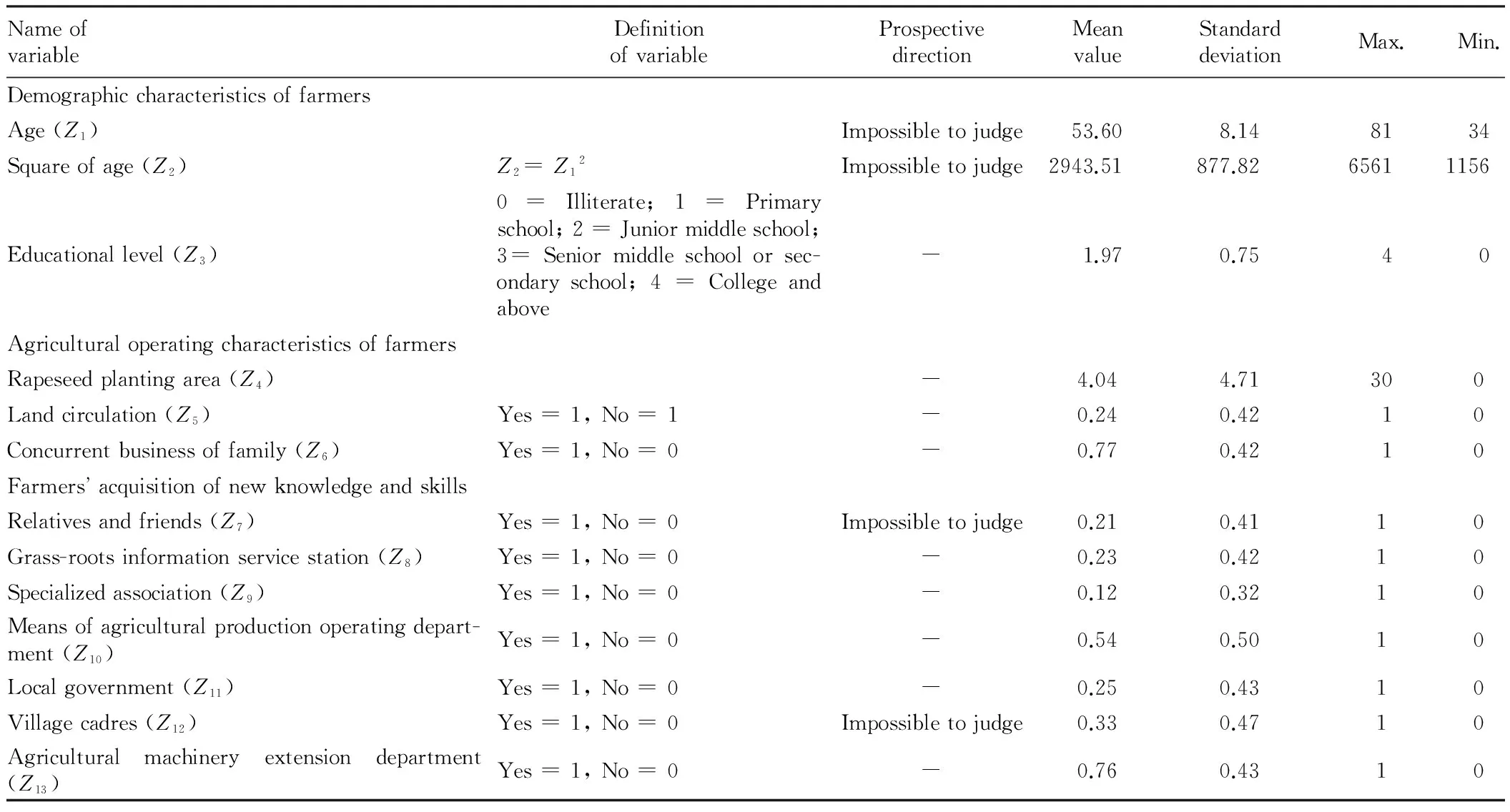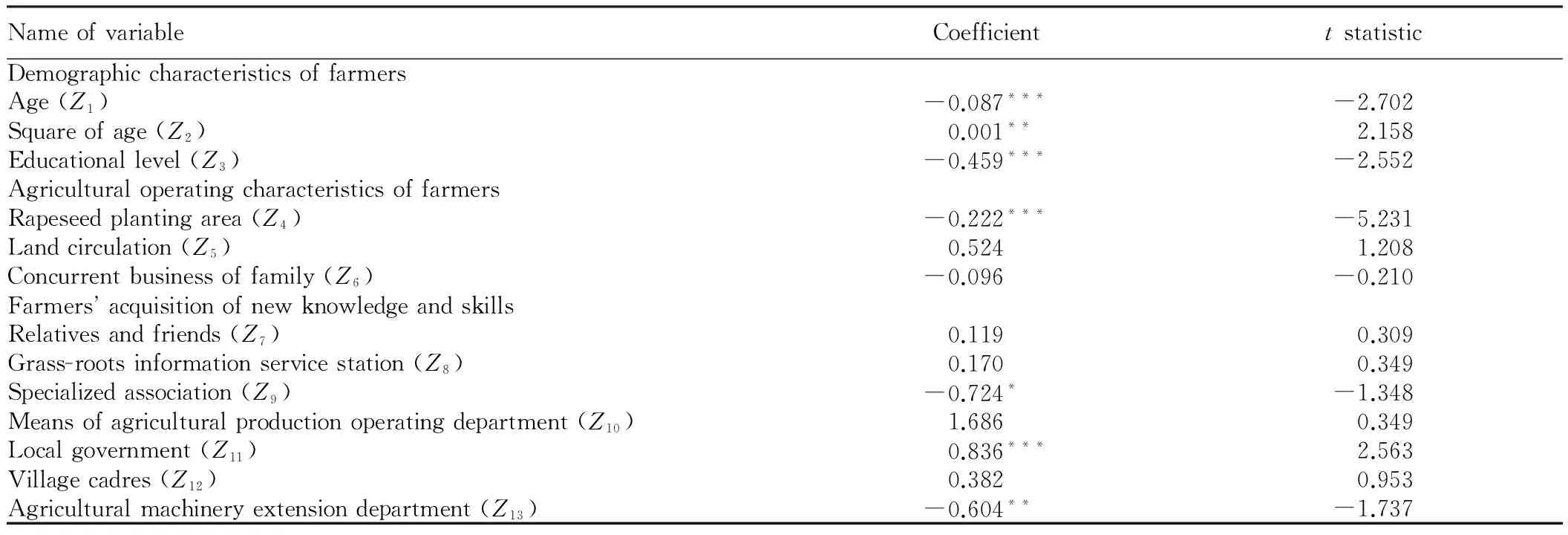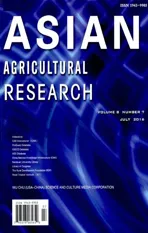Analysis on Technical Efficiency and Influencing Factors of Rapeseed Production
2016-01-12,
,
College of Economics and Management, Huazhong Agricultural University, Wuhan 430070, China
1 Introduction
China is a large rapeseed producer. Since the reform and opening-up, China’s rapeseed production has been making constant progress. Both the planting area and total yield rank first in the world, and rapeseed is widely planted in most provinces of China. Besides, rapeseed oil is a common vegetable oil in China and rapeseed oil takes up a larger portion in rapeseed supply. These bring huge demand for rapeseeds. Although domestic rapeseed production basically can satisfy raw material supply, China still imports large volume of rapeseed. In 2007, the import volume reached 30 million tons, which influences healthy development of domestic rapeseed industry. Besides, in recent years, due to small comparative benefit of rapeseed production, numerous rural young and middle-aged labors give up family agricultural production activities and go to cities to look for jobs, leading to rural labor age structure constantly becoming aging. In addition, rapeseed planting has low profit, agricultural land generally declines, rapeseed import compels domestic rapeseed purchasing price to decline, accordingly dampening farmers’ planting enthusiasm. Rapeseed farmers usually give up rapeseed and plant crops with higher income. These lead to constant shrinkage of rapeseed production and the prospect is not optimistic.
In China’s rapeseed industry, Hubei Province plays an extremely important role in rapeseed production, consumption and trade. Its rapeseed planting area has been ranking in the first place from 1996 to 2014. Besides, in total yield and high quality rate, Hubei Province ranks first, so it is of great significance and reference value to study rapeseed production of farmers in Hubei Province. In foreign countries, there are extensive researches about agricultural productivity, technical efficiency and rapeseed production. In researches of agricultural productivity, existing literature mainly adopts DEA method and stochastic frontier production function model. In the application of DEA method, Meng Lingjie[10]analyzed technical efficiency of agricultural production in 15 years. Li Ran[8]studied changes in rapeseed productivity in different regions of China by similar method. Li Gucheng made an empirical analysis of total factor productivity using DEA-Malmquist productivity index[7]. A lot of scholars studied productivity by DEA method, such as Guo Junhua, Lu Wenguang and Tian Tao[20].
In the application of stochastic frontier production function model, Tian Weietal.[17]mainly studied technical progress rate of main cotton production regions; Jin Fuliangetal.[6]made an empirical analysis on winter rapeseed production technical efficiency of 1707 different scale of farmers, and stated that it is able to effectively promote technical efficiency of farmers through large-scale land operation, optimizing resource allocation, and speeding up mechanized farming; Sun Hao[14]analyzed overall conditions and change characteristics of per unit area technical efficiency in main wheat production regions, and made comparison between regions.
In sum, most existing researches focus on overall agricultural productivity[11, 21]and regional productivity disparity[4, 6, 19]; at micro level, researches about family production efficiency focus on existing production scale[9, 12], cultivated land issue[15, 22], and resources and environment[13, 16]. However, there are few researches about production situations and technical efficiency from the perspective of demographic characteristics of rapeseed farmers. Therefore, with reference to the above researches, from the perspective of demographic characteristics, we analyzed rapeseed production, technology choice and technical efficiency of rapeseed farmers in Hubei Province.
2 Data source and demographic characteristics of fa-rmers
Data in this study were collected from 19 main rapeseed production counties in Yichang, Xiangyang, Huanggang, and Jingzhou of Hubei Province. By one-to-one field interview, we surveyed production area, production cost, sales conditions, planting psychology, and economic benefits of 344 rapeseed farmers. In these farmers, the average age is 53.6 years old with standard deviation of 8.14; 296 farmers are older than 45, accounting for 86.05% of total samples, showing the general problem of labor aging. 256 farmers have educational level at or below junior middle school, accounting for 74.42% of total samples, showing relatively low educational level. The farmland area per family is 9.42 mu, rapeseed planting area is 4.04 mu, accounting for 42.9% of total farmland area. In employment, numerous young and middle-aged rural labors go to cities, while old labors remain in rural areas. Agricultural income, migrant work, breeding, and agricultural subsidy income become major source of farmers’ family income. Among all 344 farmers, 79 farmers are pure farmers with concurrent income proportion less than 10% and account for 22.97% of total samples; 113 farmers mainly undertake agricultural production with concurrent income proportion in the range of 10%-50%, accounting for 32.85% of total samples; 151 farmers mainly undertake non-agricultural production with concurrent income proportion higher than 50%, accounting for 43.90% of total samples; only one farmer is pure non-farmer.
3 Statistical analysis of rapeseed planting
In the questionnaire, 213 farmer families have more than a half of "the number of family labors" being "migrant workers", accounting for 61.92% of total samples, indicating that more than a half farmer families have insufficient agricultural labor, most young and middle-aged labors prefer to do migrant work. In the surveyed area, agricultural labors for rapeseed production are in short. Considering the influencing of aging, labor demand in busy farming season is more intense. The multiple choice question "reasons for your increasing or reducing rapeseed planting area in the next year" can reflect planting intention and technical choice tendency of farmers. A total of 295 farmers answered this question. The results are listed in Table 1, from which it can be seen that high cost of means of production is the main reason for farmers changing their rapeseed planting area, the next reason is high labor input, and finally is labor scarcity. In addition, rise of rapeseed price, fine seed policy, seasonal conflict, and low planting benefits also influence farmers’ planting area.
315 farmers answered the question "Is there specialized rapeseed association nearby?", about 224 farmers joined the specialized rapeseed association. In these 224 farmers, 191 farmers are equal to or older than 45, accounting for 70.22% of the age group; 33 farmers are younger than 33, accounting for 76.74% of the age group, showing that most farmers join specialized rapeseed associations to seek specialized assistance. The proportion of old farmers joining specialized rapeseed associations is lower than that of young and middle-aged groups.
Table1Reasonsforfarmersincreasingorreducingrapeseedplantingarea

ReasonsFrequencyPercentage//%Fineseedpolicy10214.17Riseofrapeseedprice10815.00Costofmeansofproduction16122.36Highlaborinput15421.39Laborscarcity12617.50Seasonalconflict496.81Lowplantingbenefit202.78
4 Model building and description
In this study, we mainly applied stochastic frontier production function to analyze the productivity. This method was firstly applied in cross-sectional data, and then widely applied in stochastic frontier production analysis of panel data in various fields. Besides, based on the stochastic frontier model proposed by Batteseetal.[2], we adopted trans-log production function with flexible form. Both input and output adopt logarithmic form. Also, we introduced quadratic term, which effectively avoids the assumption of neutral technology and fixed output. Then, we studied interaction of input factors and their influence on explained variables, and the difference in technological progress of technical factors, and improved estimation accuracy of progress rate of technical efficiency growth[17]. Production function applied in this study is as follows:
lnYi=b0+b1lnLd1+b2lnLri+b3LnF+b4lnPi+b3lnSi+b6lnMi+b7(lnLdi)2+b8(lnLri)2+b9(lnFi)2+b10(lnPi)2+b11(lnSi)2+b12(lnMi)2+b13(lnLdi)2)(lnLri)+b14(lnFi)+b15(lnLdi)(lnPi)+b16(lnLdi)(lnSi)+b17(lnLdi)(lnMi)+b18(lnLri)(lnFi)+b19(lnLri)(lnPi)+b20(lnLri)(lnSi)+b21(lnLri)(lnMi)+b22(lnFi)(lnPi)+b23(lnFi)(lnSi)+b24(lnFi)(lnMi)+b25(lnPi)(lnSi)+b26(lnPi)(lnMi)+b27(lnSi)(lnMi)+(Vi-Ui)
(1)
In this study, we adopted micro cross-sectional data of farmers in Hubei Province of the year 2013, and madeT= 1 when setting stochastic frontier and in-efficiency model. Although existing literature mainly adopts time series data, since our study object is traditional rapeseed production area, agricultural technology is relatively stable, cross-sectional data can well reflect technical features[5].
Table 2 lists names of selected variables and description statistics:Yidenotes total rapeseed yield of familyi, expressed in jin/family;Ldidenotes rapeseed planting area of familyi, expressed in mu/family;Lridenotes labor input of familyi, expressed in people/family;Fidenotes chemical application of familyi, expressed in yuan/family;Pidenotes pesticide input of familyi, expressed in yuan/family; Si denotes seed input of familyi, expressed in yuan/family;Midenotes mechanical operation cost of familyi, expressed in yuan/family;bkdenotes parameter to be estimated (k= 0, 1, 2…14);Vit-Uitdenotes compound disturbance term andVitis stochastic error term, representing stochastic factor and error influencing final output, submitting to normal distribution of zero mean value and variance ofσv2. Uit is non-negative stochastic variable submitting to half-normal distribution, represents technical efficiency loss, and mainly used to reflect inefficiency degree of production, the mean value isμ, and variance isσu2. For data with input variable being zero, assign it to 1 when entering the trans-log production function model, after logarithmic operation,ln1 = 0, so it does not change significance of original data.
Table2Descriptivestatisticsofinputandoutputvariablesoffarmers’rapeseedproduction

NameofvariableMeanvalueStandarddeviationMin.Max.Totalrapeseedyield(Yi)∥jin/family1362.621629.83010000Rapeseedplantingarea(Ldi)∥mu/family4.044.71030Laborinput(Lri)∥people/family1.510.7604Chemicalfertilizer(F)∥yuan/family452.62554.0003800Pesticide(P)∥yuan/family83.08106.140780Seed(S)∥yuan/family77.51116.790800Mechanicaloperationcost(M)∥yuan/family248.47375.2601980
Actual operation formula of technical efficiency follows the event in-efficiency[1]model:

(2)
where E(·) is mathematical expectation. IfUit= 0,i.e.TEit= 1, denoting familyihas technical efficiency complete free of loss; ifUit>0, 0 The efficiency loss model is set to be: (3) In model (3),Zhiis influencing factor possibly leading to difference in technical efficiency between farmers. On the basis of researches of Battese[3]and Schultz (1987), combined with purpose of this study, we divided factors influencing farmers’ technical efficiency into three types: demographic characteristics of farmers, agricultural operating characteristics of farmers, and farmers’ acquisition of new knowledge and skills, including a total of 13 variables. Statistical analysis is listed in Table 3. Table3Definitionanddescriptivestatisticsoftheefficiencylossmodel NameofvariableDefinitionofvariableProspectivedirectionMeanvalueStandarddeviationMax.Min.DemographiccharacteristicsoffarmersAge(Z1)Impossibletojudge53.608.148134Squareofage(Z2)Z2=Z12Impossibletojudge2943.51877.8265611156Educationallevel(Z3)0=Illiterate;1=Primaryschool;2=Juniormiddleschool;3=Seniormiddleschoolorsec-ondaryschool;4=Collegeandabove-1.970.7540AgriculturaloperatingcharacteristicsoffarmersRapeseedplantingarea(Z4)-4.044.71300Landcirculation(Z5)Yes=1,No=1-0.240.4210Concurrentbusinessoffamily(Z6)Yes=1,No=0-0.770.4210FarmersacquisitionofnewknowledgeandskillsRelativesandfriends(Z7)Yes=1,No=0Impossibletojudge0.210.4110Grass-rootsinformationservicestation(Z8)Yes=1,No=0-0.230.4210Specializedassociation(Z9)Yes=1,No=0-0.120.3210Meansofagriculturalproductionoperatingdepart-ment(Z10)Yes=1,No=0-0.540.5010Localgovernment(Z11)Yes=1,No=0-0.250.4310Villagecadres(Z12)Yes=1,No=0Impossibletojudge0.330.4710Agriculturalmachineryextensiondepartment(Z13)Yes=1,No=0-0.760.4310 5.1ResultsofparameterestimationWe mainly adopted frontier4.1 software to estimate the above models. If γ = 0 is accepted, it can be deemed there is no efficiency loss. If γ statistic is significant, it means there is technical efficiency loss. Results of parameter estimation are listed in Table 4. Table4Parameterestimationresultsofstochasticfrontierproductionfunctionmodel ItemCoefficientEstimatedvaluetstatisticConstanttermb00.259***4.415lnLdb10.479*1.322lnLrb26.380***13.76lnFb30.623***3.456lnPb40.773***2.992lnSb5-1.184***-7.741lnMb61.239***19.500(lnLd)2b70.131*1.555(lnLr)2b80.324*1.604(lnF)2b90.036*1.795(lnP)2b100.0390.504(lnS)2b110.054***4.067(lnM)2b120.046***4.123(lnLd)(lnLr)b131.493***10.530(lnLd)(lnF)b14-0.195**-2.295(lnLd)(lnP)b150.0230.200(lnLd)(lnS)b16-0.324***-6.573(lnLd)(lnM)b170.328***12.800(lnLr)(lnF)b18-0.787***-8.098(lnLr)(lnP)b19-0.905***-7.541(lnLr)(lnS)b20-0.082*-1.860(lnLr)(lnM)b210.048*1.506(lnF)(lnP)b22-0.050-0.985(lnF)(lnS)b230.170***6.643(lnF)(lnM)b24-0.202***-13.420(lnPi)(lnSi)b250.104***2.961(lnPi)(lnMi)b26-0.158***-6.804(lnSi)(lnMi)b27-0.028***-4.217σ21.062***8.155γ0.961***103.900Samplesize344.000 Note: degree of freedom approximate value 120,***,**and*denote significance level at 1%, 5% and 10% level respectively. Table 4 indicates that γ value is 0.961 and significant at 1%, showing technical in-efficiency is main source of variation in compound disturbance term, accounting for 96.1%; rapeseed production has technical in-efficiency, and 96.1% of total disturbance can be explained, and only 3.9% comes from external influence such as statistical error. According to results of parameter estimation, firstly, labor, chemical fertilizer, pesticide, seed, mechanical operating cost in rapeseed production are significantly correlated with total yield of family at 1% statistical level. Secondly, labor and mechanical operating cost have significant complementary relationship with land, indicating that expansion of planting area is inseparable from effective support of labor and mechanical input, while reduction of labor results in shortage of labor for maintaining original planting area. Chemical fertilizer and seeds have significant replaceable relationship with land, indicating that farmers can save land through applying new high-yield chemical fertilizer and new crops that have high reaction to chemical fertilizer. Thirdly, chemical fertilizer, pesticide, and seeds have significant replaceable relationship with labor, indicating that fine seed and scientific, high efficient and reasonable application of chemical fertilizer can effectively reduce labor input. Fourthly, there is complementary relation between chemical fertilizer and seed, but significant replaceable relation with mechanical operating cost, indicating that high yield and new crops can save land and reduce input of mechanical operating cost. Fifthly, there exists significant complementary relation between pesticide and seed, while there is significant replaceable relation between pesticide, seeds and mechanical operating cost, indicating that combination of high efficient pesticide and fine seed can increase rapeseed output, and effectively save mechanical input cost. Facing labor shortage in busy farming season, major solutions for farmers include applying high yield fine seed, increasing chemical fertilizer and scientific utilization rate, and high efficient and reasonable application of chemical fertilizers. Besides, combination of mechanical operation can alleviate labor shortage and realize conserved use of resources to a certain extent. Derive logarithm of input factors in two sides of model (1), we can obtain elastic calculation formula of input factors: εLd=b1+2b7lnLdi+b13lnLri+b14lnFi+b15lnPi+b16lnSi+b17lnMi (4) εLr=b2+2b8lnLri+b13lnLdi+b18lnFi+b19lnPi+b20lnSi+b21lnMi (5) εF=b3+2b9lnFi+b14lnLdi+b18lnLri+b22lnPi+b23lnSi+b24lnMi (6) εP=b4+2b10lnPi+b15lnLdi+b19lnLri+b22lnFi+b25lnSi+b26lnMi (7) εS=b5+2b11lnSi+b16lnLdi+b19lnLri+b23lnFi+b25lnPi+b27lnMi (8) εM=b6+2b12lnMi+b17lnLdi+b21lnLri+b24lnFi+b26lnPi+b27ln/Si (9) Take average value of logarithms of input factors for rapeseed planting farmers, substitute estimated results of Table 4 and mean value into elastic calculation formula, we obtain average output elasticity of input factors, as shown in Table 5. Table5Averageoutputelasticityofinputfactorsofrapeseedplantingfarmers InputfactorsAverageoutputelasticityRapeseedplantingarea(Ld)0.612Laborinput(Lr)0.797Chemicalfertilizer(F)0.105Pesticide(P)0.285Seed(S)-0.076Mechanicaloperatingcost(M)0.204 In the average elasticity of input factors, only the elasticity of seeds is negative, indicating that seed use is relatively surplus in rapeseed planting. Increase in seed input will not bring effective increase of output. Thus, it is recommended to use fine seeds to increase yield. The average elasticity of rapeseed planting area, labor input, chemical fertilizer, pesticide and mechanical operating cost is positive, indicating input of these production factors is relatively low. Therefore, increasing input of such production factors can increase rapeseed yield. The average output elasticity of rapeseed planting area and labor input is high, indicating planting area and labor still play an important role in agricultural development, and increasing planting area and labor input can significantly increase rapeseed yield. In comparison, the average output elasticity of pesticide and mechanical operating cost is small, reflecting the input of these three factors have reached certain level, increasing their input can increase output, but the effect of yield increase is not significant, effective yield increase needs reasonable and scientific choice of all input factors. 5.2ComparisonanalysisontechnicalefficiencyoffarmersindifferentagegroupsAverage technical efficiency level of sample farmers is 0.7879 with standard deviation of 0.1368. 48 farmers have technical efficiency level higher than 0.9, accounting for 13.95% of total samples. 229 farmers have technical efficiency in the range of 0.7-0.9, accounting for 66.57% of total samples, and the rest farmers have technical efficiency lower than 0.7, indicating that most farmers have low technical efficiency of rapeseed production and the efficiency is to be improved. The age of farmers is in 34 to 81 years old. To study technical efficiency characteristics of different age groups, we divided their age into four groups: [34,45), [45,55), [55,65), and [65,81], respectively representing young, middle age, old age, and venerable age labors. Technical efficiency distribution, average value and standard deviation of four groups are shown in Fig. 1 and Table 6. It can be seen that the distribution density of [45,55) and [55,65) age groups is the highest, the fluctuation of technical efficiency of [65,81] age group is the lowest, while the fluctuation of technical efficiency of [55,65) age group is the highest and the average technical efficiency level is the lowest, while the average technical efficiency of age group [45,55) is the highest. These indicate that middle and old aged farmers have highest average technical efficiency level, technical efficiency level of farmers older than 65 is stable, while technical efficiency and fluctuation of young and middle aged farmers remain at the intermediate level. Table6Technicalefficiencyaveragevalueandstandarddeviationoffarmersindifferentagegroups AgegroupAveragevalueStandarddeviation[34,45)0.7850.134[45,55)0.7980.126[55,65)0.7790.155[65,81]0.7880.090 5.3Analysisofestimationresultsofefficiencylossmodel 5.3.1Influence of demographic characteristics of farmers on technical efficiency. Table 7 indicates that age coefficient of agricultural labor (Z1) is -0.087, smaller than 0 and passes significance test at 1% level, the square coefficient (Z2) is 0.001, higher than 0 and passes significance test at 5% level, sign ofZ1andZ2is opposite, indicating that labor age has significant influence on technical in-efficiency, the curve takes on U shape. With the increase of farmers’ age, their technical efficiency firstly declines then rises, possible because increase of age will bring rich experience to farmers, they will reduce efficiency loss, while they reach certain age, the aging problem will make their physical power and intelligence level decline and consequently increase the efficiency loss. Educational level of farmers exerts significant negative influence on technical efficiency loss, indicating that it is possible to reduce technical efficiency loss through raising educational level of farmers. Farmers with high educational level will be more sensitive to new technology, new equipment and agricultural input, and can better grasp the situation and conform to expected situations. Table7Estimationresultsofefficiencylossmodel NameofvariableCoefficienttstatisticDemographiccharacteristicsoffarmersAge(Z1)-0.087***-2.702Squareofage(Z2)0.001**2.158Educationallevel(Z3)-0.459***-2.552AgriculturaloperatingcharacteristicsoffarmersRapeseedplantingarea(Z4)-0.222***-5.231Landcirculation(Z5)0.5241.208Concurrentbusinessoffamily(Z6)-0.096-0.210FarmersacquisitionofnewknowledgeandskillsRelativesandfriends(Z7)0.1190.309Grass-rootsinformationservicestation(Z8)0.1700.349Specializedassociation(Z9)-0.724*-1.348Meansofagriculturalproductionoperatingdepartment(Z10)1.6860.349Localgovernment(Z11)0.836***2.563Villagecadres(Z12)0.3820.953Agriculturalmachineryextensiondepartment(Z13)-0.604**-1.737 Fig.1 Technical efficiency distribution of farmers in different age groups 5.3.2Influence of agricultural characteristics of farmers on technical efficiency. The rapeseed planting area of farmers has significant negative influence on technical efficiency loss and is statistically significant at 1% level, consistent with the expectation. Expanding the planting area can effectively reduce the efficiency loss and manifest function of large scale economy. 5.3.3Influence of acquisition of new knowledge and skills on technical efficiency. Local government has significantly positive influence on technical efficiency loss, the direction is opposite to expectation, possibly because technology provided by government may not suit local conditions well. Specialized association and agricultural machinery extension department have significant negative influence on technical efficiency loss, which is consistent with the expectation. Specialized association and agricultural machinery extension department are situated in grass-roots area, are grass-roots department closest to farmer production, so they can provide effective technical support and guidance, help farmers to reduce loss of technical efficiency. (i) Sample rapeseed farmers in Hubei Province have serious aging problem. Labor is relatively insufficient in busy farming season. High cost of production means and labor input and shortage of labor are major reasons influencing farmers reducing rapeseed planting area. Therefore, effective production cost control and preferential policy to attract labor return can effectively realize increase in rapeseed yield. (ii) The average efficiency level of rapeseed planting of sample farmers in Hubei Province is 78.79% with standard deviation of 0.1368. This indicates that if other factors are not changed, maintaining existing production conditions and productivity and eliminating disturbance of efficiency loss, it is possible to raise the technical efficiency of farmers’ rapeseed production by 21.21%. (iii) In the process of rapeseed planting, seed input is relatively saturated, increasing input will not bring increase of technical efficiency. Therefore, it is recommended to adopt high yield high quality fine seed, scientifically apply chemical fertilizers and pesticide, conduct mechanical farming to alleviate the problem of labor shortage, to realize conserved use of resources. (iv) Middle aged and old farmers have richer production efficiency than young farmers, while acceptance ability of new technology and formula of young farmers is high, so they have the highest average technical efficiency. Farmers older than 65 are stable in technical efficiency, while young and middle aged farmers lack efficiency and their stability degree is to be improved, so their technical efficiency and fluctuation remain in the intermediate level. (v) Labor age makes the technical efficiency take on U shape. In other words, efficiency loss firstly declines and then increases. Increase of educational level and realization of scale economy can effectively reduce the purpose of technical efficiency loss. Therefore, local government, specialized associations and agricultural machinery extension department should provide technical guidance consistent with demands of farmers, to reduce loss of technical efficiency. [1] BATTESE GE. Frontier production functions and technical efficiency: A survey of empirical applications in agricultural economics[J]. Agricultural Economics, 1992, 7(3-4): 185-208. [2] BATTESE GE, COELLI TJ. Frontier production functions, technical efficiency and panel data: With application to paddy farmers in India[J]. Journal of Productivity Analysis, 1992, 3(1-2): 153-169. [3] RAY TREWIN, LWG, SJAIFUL E,etal. Analysis of the technological efficiency over time of west javanese rice farms[J]. Australian Journal of Agricultural and Resource Economics, 1995, 39(2): 143-163. [4] FANG H. Study on the agricultural production technology efficiency in China[J].Journal of Agrotechnical Economics, 2010(1):34-41. (in Chinese). [5] GUO XM, ZUO ZY. Analysis on the selection and technical efficiency of peasant households in traditional agricultural areas based on the angle of aging[J]. Journal of Agrotechnical Economics,2015(1):42-53. (in Chinese). [6] JIN FL, WANG L, LI GC,etal. Winter rapeseed’s technical efficiency and its influence factors. Based on the model of stochastic frontier production function and 1 707 micro-datas of farmers[J]. Journal of China Agricultural University,2013,18(1):210-217. (in Chinese). [7] LI GC. Technical progress, technical efficiency, and productivity growth of China’s agriculture[J]. Economic Review,2009(1):60-68. (in Chinese). [8] LI R, FENG ZC. Analysis of rape productivity growth and convergence in various regions of China[J]. Journal of Huazhong Agricultural University(Social Sciences Edition),2010(1):27-31. (in Chinese). [9] LI R, LI GC, FENG ZC. Analysis on technical efficiency of rapeseed production by different scale households-Based on survey data from 689 households of Hubei, Sichuan and other four provinces[J]. Journal of Huazhong Agricultural University(Social Sciences Edition),2015(1):14-22. (in Chinese). [10] MENG LJ. A dynamic study on efficiency of agricultural output technology in China[J]. Journal of Agrotechnical Economics,2000(5): 1-4. (in Chinese). [11] PENG DY, WU X. A study on China's agricultural technology efficiency and TFP-A perspective on the changes in the structure of rural labor force[J]. Economist,2013(9): 68-76. (in Chinese). [12] QU XB. Technical efficiency of different farmer sizes and its influencing factors-Based on stochastic frontier production function and micro-data of households[J]. Journal of Nanjing Agricultural University(Social Science Edition),2009,9(3):27-35. (in Chinese). [13] SU Y, MA HL, LI F. The farmers’ technical efficiency and its influencing factors from the perspective of carbon emissions-A case of Awat,Xinjiang[J]. Journal of Arid Land Resources and Environment,2014(10):26-30. (in Chinese). [14] SUN H. Analysis on stochastic frontier of production technology efficiency of wheat[J]. Journal of Agrotechnical Economics,2014(1):42-48. (in Chinese). [15] TAN SH, NICO H, QU FT. Impact of land fragmentation on small rice farmers’ technical efficiency in Southeast China[J]. Scientia Agricultura Sinica,2006,39(12):2467-2473. (in Chinese). [16] TIAN W, LIU SW. Analysis on regional difference and convergence of agricultural technology efficiency in China[J]. Problems of Agricultural Economy,2012(12):11~18. (in Chinese). [17] TIAN W, LI MX, TAN DD. The calculation and analysis of the rate of technical progress of Chinese cotton production[J]. China Rural Survey,2010(2):45~53. (in Chinese). [18] TIAN W, YANG LJ, JIANG J. The calculation and analysis of the rate of Chinese agricultural environmental efficiency under the perspective of low carbon[J]. China Rural Survey,2014(5):59~71. (in Chinese). [19] WANG F, LUO JC. An empirical analysis on the differences of farmers’ production technology efficiency in the eastern, central and western regions of China ——Based on the analysis of ISDF model[J]. Journal of Agrotechnical Economics,2012(3):55-64. (in Chinese). [20] TIAN T, XU XC, ZHOU KJ. Study on the production efficiency of oilseed rape in each city of Anhui Province——Based on the empirical analysis of DEA[J]. Journal of Agrotechnical Economics,2011(12):46-52. (in Chinese). [21] YAN PF, WANG B. On the increase of technical efficiency, technical progress and rate of production:Based on the empirical analysis of DEA[J]. Economic Research Journal,2004(12):55-65. (in Chinese). [22] ZHANG HX, YANG GQ. The effects of land fragmentation on technical efficiency of food production :An empirical analysis based on stochastic frontier production function and micro-data of households[J]. Resources Science,2012,34(5):903-910. (in Chinese). [23] ZHOU SD, WANG Y, ZHU SZ. Analysis on the technical efficiency of peanut production farmers in China and its influencing factors[J]. Chinese Rural Economy,2013(3):27-46. (in Chinese).
5 Results of empirical analysis and explanation





6 Conclusions
杂志排行
Asian Agricultural Research的其它文章
- Economic Analysis on the Rational Allocation of Agricultural Production Factors in Henan Province
- Special Space and Plant Landscape Design of Urban Ecological Buildings
- Main Methods Applied in Fertigation Technology
- A Study on the Ultrasonic Extraction and Antioxidant Activity of Lychee Pericarp Polysaccharides
- The Fishery Industrial Structure in China Based on the Application of Shift-Share Analysis
- Spatial Structure of Tourism Resources in Liaoning Province
